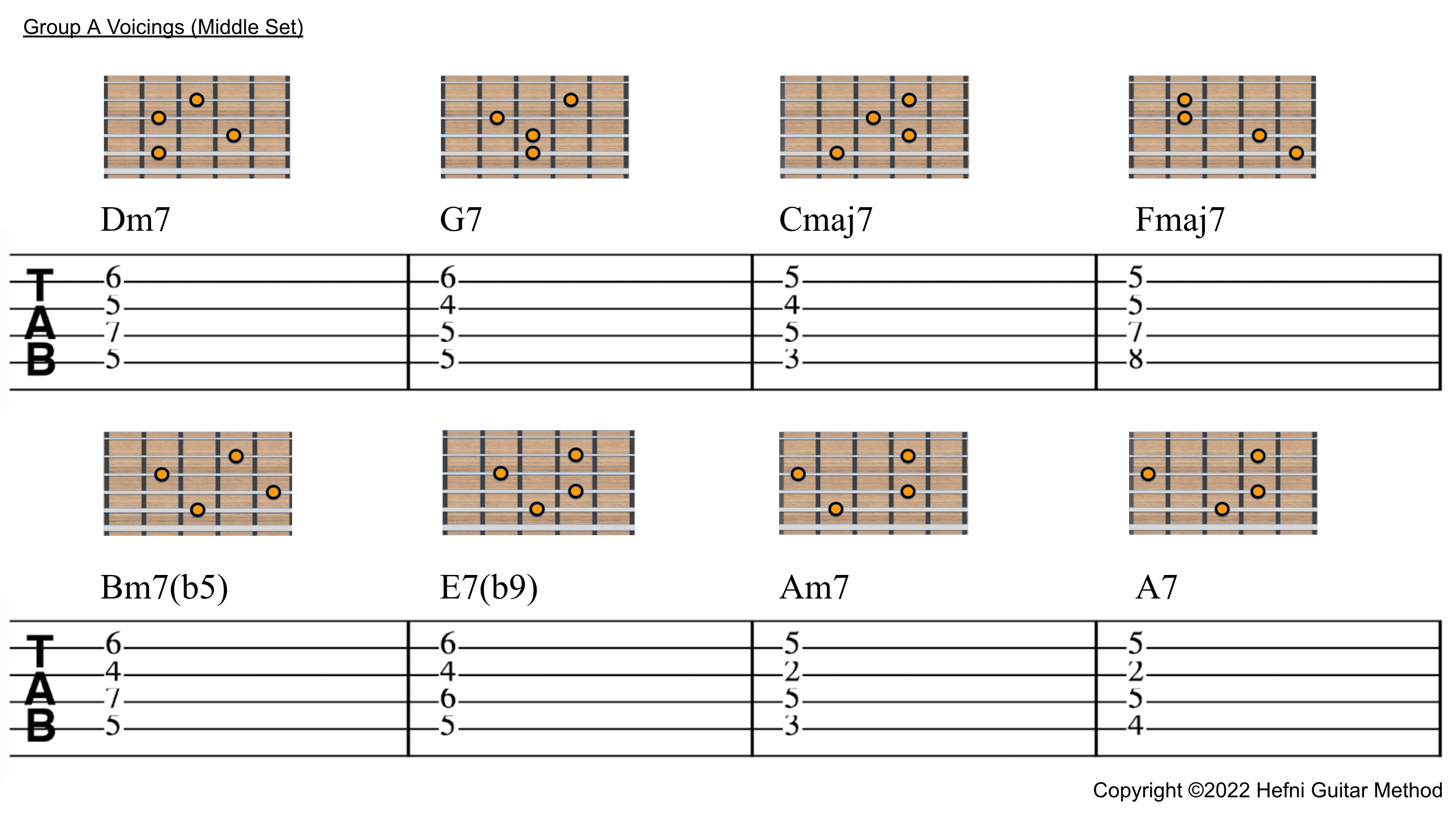Welcome to the Jazz Chords Workshop. Here we will introduce the fundamental 7th chords as used in the Jazz II-V-I progressions. I will assume you already have some basic music theory.
For the entire course, we will be using the chord progression (shown right) sometimes called the ‘Circle of 5th progression’. This 8-bar progression contains both the major II-V-I (in bars 1 to 3) and the minor II-V-I in bars 5 to 7.

Simply learn the 8-bar progression as presented in this lesson. However, you may choose to break it up and learn them separately. Learn the first 4 bars and subsequently the next 4 bars. Once you are proficient with both, connect the major and minor II-V-I progressions into the 8-bar sequence. This progression is cyclic which means you can repeat the entire progression again after bar 8.
Watch the video below to begin the lesson.
Learning Aids
Lesson 1 introduces these chord voicings in C major centred around the 5th and 8th frets. We will begin on the middle group of 4 strings. As such, let us call this Group A voicings (middle)
The chord shapes and TABs are as follows.

Primary Takeaways
The main takeaways of lesson 1 are as follows:
1. Learn the 7th chords as part of a group ‘sequence’.
As you progress with your learning, you will encounter these 7th chords regularly as part of these group sequences. For this lesson, this ‘voicing group’ lies between the 5th and 8th frets. By learning them in sequences you will always know what chord comes next and more importantly, how to change accordingly,
2. The chords in the major II V I and minor II V I differ by a single note.
Take a look at the Dm7 in bar 1 and the Bm7(b5) in bar 5.
If we were to move the C note in Dm7 back a half step, we actually get a Bmin7(b5). Similarly, to get the E7(b9) chord in bar 6, we simply amend one note from the G7 chord in bar 2. This note is the root note and we shall shift it up one fret. Lastly to get the Am7 chord in bar 7, we simply shift the note in Cmaj7 in bar 3, held by our middle finger, down 2 frets. We might need to reconfigure our fingers to hold this new shape.
At this stage of the course, we are more concerned with the mechanics of holding the chord and how to change between chords. We will explore the theory at a later lesson. For now, the main takeaway here is that the chords in both major and minor II-V-I’s, differ by a single note.
3. Memorize the ‘Circle of 5th’ progression
The circle of 5th progression is commonly used in a lot of songs and not only in the Jazz genre. For instance, it is used in these songs;
-
-
-
- ‘Spain’ – Chick Corea,
- ‘Fly me to the Moon’ – Bart Howard,
- ‘I Will Survive’ – Gloria Gaynor etc.
-
-
albeit in different keys. You can enhance your learning by trying to transpose and/or adapt the chord voicings learnt in this lesson to some of those songs.
Tips for Better Learning
Not everyone learns the same way. Some of you might find the exercise in this lesson easy. Others might find it challenging. There is nothing wrong in learning at a different pace.
Nonetheless, if you are having some difficulty with today’s lesson, a good way to navigate through it is to break the exercise up into smaller fragments.
Instead of learning the entire passage, learn bars 1 to 4 first. This fragment can be repeated as 4 bar chord progression and it will help you master the major II V I in this position.
Once you’ve nailed this, begin learning the next 4 bars. In other words, we are learning the II-V-I’s separately. However, once we’ve gotten good at both, simply combine them into the 8 bar progression as intended.
Take your time to learn these chord changes before proceeding to lesson 2.
